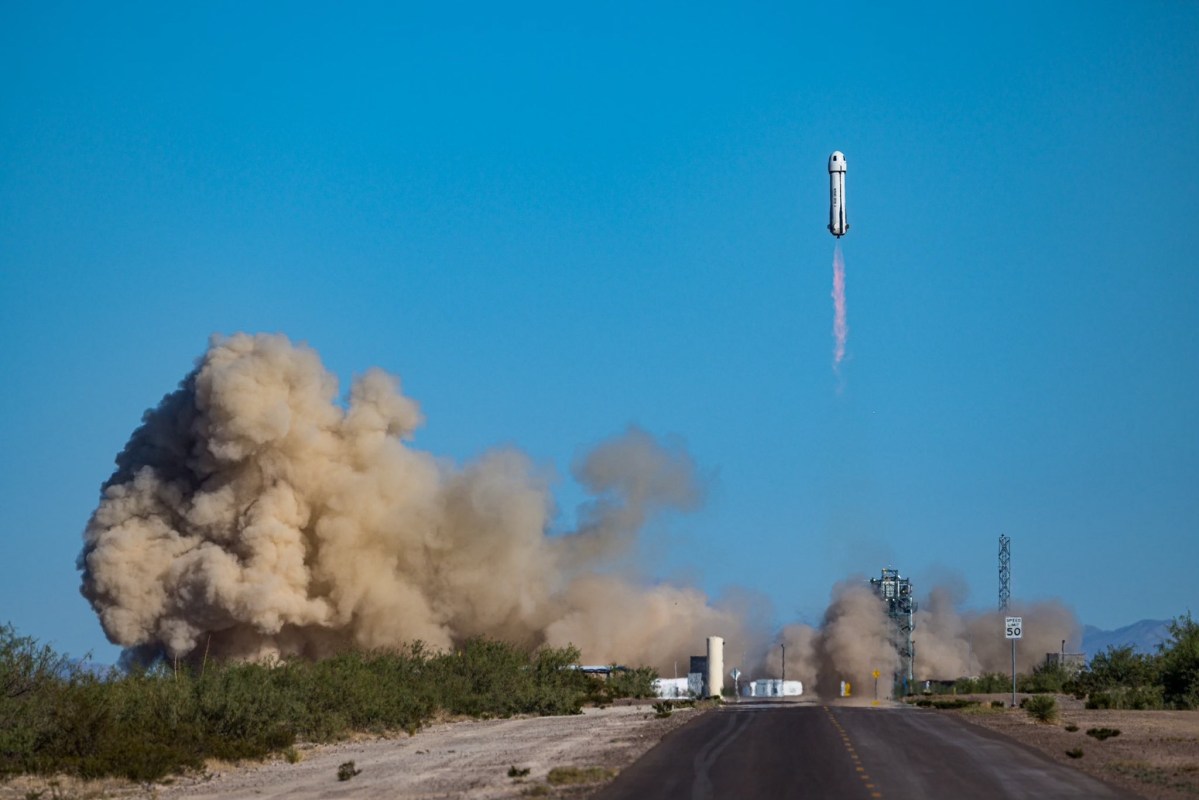WASHINGTON — Blue Origin carried out the first flight of a new model of its New Shepard suborbital vehicle Oct. 23, a mission the company called “nominal and on target” despite going to a slightly lower altitude than past flights.
The uncrewed NS-27 mission lifted off from Blue Origin’s Launch Site One in West Texas at 11:26 a.m. Eastern. The company had scrubbed an initial launch attempt Oct. 7 for unspecified technical issues that could not be resolved before the launch window closed, and Blue Origin called off a second attempt Oct. 13 “to troubleshoot a GPS issue.”
Unlike past New Shepard flights, the company did not publicly release statistics about the flight, including peak altitude and speed. The webcast of the flight followed the booster, not the capsule, after separation, showing it appear to reach a peak altitude of about 101.2 kilometers above ground level, or 102.3 kilometers above mean sea level. By comparison, on the previous New Shepard flight, NS-26 on Aug. 29, the booster reached a peak altitude of 105.3 kilometers above sea level.
Blue Origin, in response to a SpaceNews inquiry, confirmed late Oct. 23 that the booster reached a peak altitude of 102.3 kilometers above sea level while the capsule flew to an apogee of 102.4 kilometers. On NS-26, the capsule went to 105.4 kilometers. Previous New Shepard flights, both crewed and uncrewed, have typically flown to altitudes of between 105 and 107 kilometers above sea level.
The company didn’t explain the lower altitude of the flight. “Flight performance was nominal and on target for this shakeout mission,” a company spokesperson told SpaceNews.
A review of video of the NS-26 and NS-27 missions appears to show that engine shutdown on NS-27 took place about two seconds earlier than the previous flight. NS-26 had a maximum ascent speed at engine shutdown of 3,602 kilometers per hour while NS-27’s maximum ascent speed was 3,473 kilometers per hour, according to data released by Blue Origin. A lower speed at engine shutdown would result in a lower apogee.
The flight was the first for a new model of both the New Shepard capsule, called RSS Kármán Line, and the booster. “The vehicle features technology upgrades to improve the vehicle’s performance and reusability, an updated livery, and accommodations for payloads on the booster,” Blue Origin said in an Oct. 4 statement. On this initial flight, the vehicle did not carry people but did include 12 payloads, such as a Blue Origin navigation systems developed for both New Shepard and its New Glenn orbital launch vehicle.
RSS Kármán Line, named after the 100-kilometer altitude often used as the boundary of space, is Blue Origin’s second human-rated New Shepard capsule, joining RSS First Step. Blue Origin said the second capsule will provide “expanded flight capacity to better meet growing customer demand.” The company did not elaborate on its projected flight rate or date of its next mission during the launch webcast or in a statement after the flight.
One scientist’s experience on New ShepardThe growing customer demand Blue Origin sees is likely to come predominantly from tourists. However, on NS-26 the company flew a NASA-funded researcher for the first time: Rob Ferl, a professor at the University of Florida, who carried out an experiment to see how the stresses of spaceflight affect gene expression in plants.
At an Oct. 9 meeting of the Committee on Biological and Physics Sciences in Space of the National Academies’ Space Studies Board, Ferl and his colleague, Anna-Lisa Paul, said his training for the flight started two years earlier with a mockup capsule, practicing the timing of various aspects of the experiment, which involve pressing plungers on tubes containing the plants. That was followed by hundreds of practice runs in the lab “so that it was absolutely in his muscle memory,” Paul said.
Ferl said his research team reached out to astronauts and people who had flown on New Shepard and Virgin Galactic’s SpaceShipTwo for advice, as well as sports psychologists. He likened the training for the suborbital flight for what an athlete goes through preparing for the Olympics. “They were getting ready to take a trip away from home, to do to a performance of their lifetime, in a place and time that was strange and under a lot of pressure, and to be able to perform at a high level while also enjoying the event,” he said.
That helped in developing the checklist for the flight as well as things like color-coordinating experiment tubes to correspond with the phases of flight they should be activated. “We had a group muscle memory of when things were going to happen in flight,” he said.
All that training was intended to show that scientists could carry out experiments on suborbital vehicles, said Ferl, who has been an advocate of using commercial suborbital vehicles for research. “We’re scientists, but we’ve got to remember that we’re human beings and we’re in an extraordinary, singular environment where things have to happen in real time and accurately so that you don’t blow the opportunity.”
The flight, and the experiment, went well. “One of my first words coming out of the capsule was, ‘Did I do the right thing? Did they get done?’ Because the experience is so dramatic that there are chances for you to go stupid,” he recalled.
Paul said the team checked the experiment tubes just after landing “to start cataloging whether he did everything right. He did.” Analysis of the data from the flight is ongoing.
While Ferl spent two years training for the NS-26 flight, he said future scientists should be able to do so in much less time, citing progress by both Blue Origin and Virgin Galactic in setting up operational guidelines and procedures for experiments. “I think we could have been comfortable doing this in three and a half months, or something like that.”
